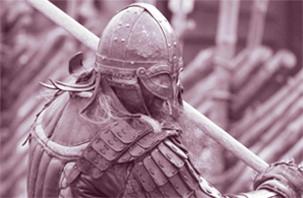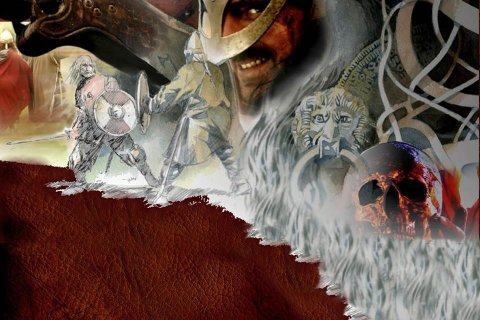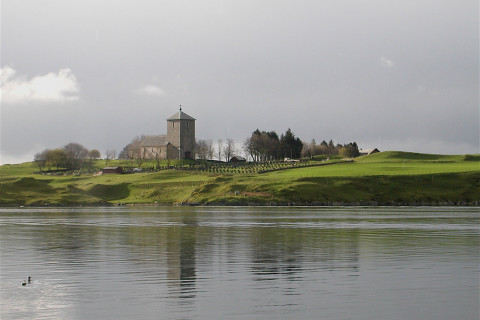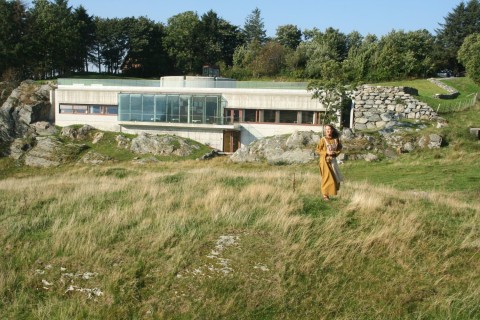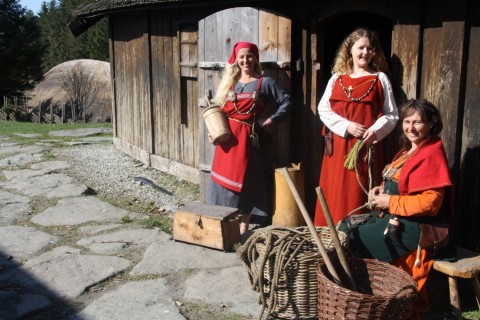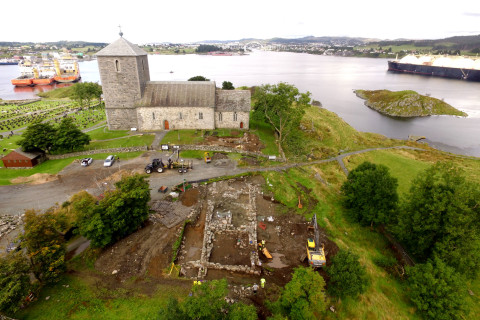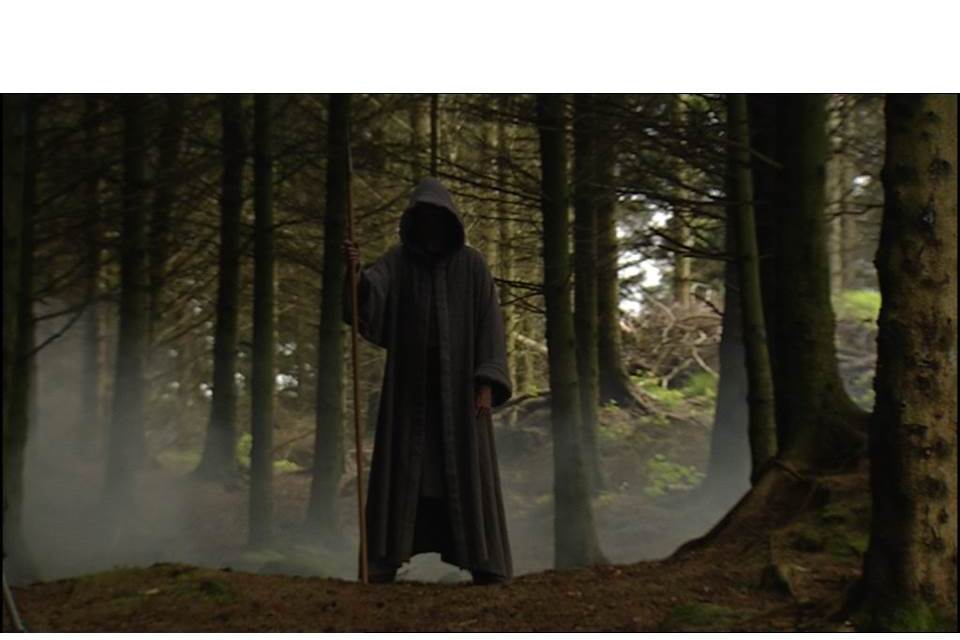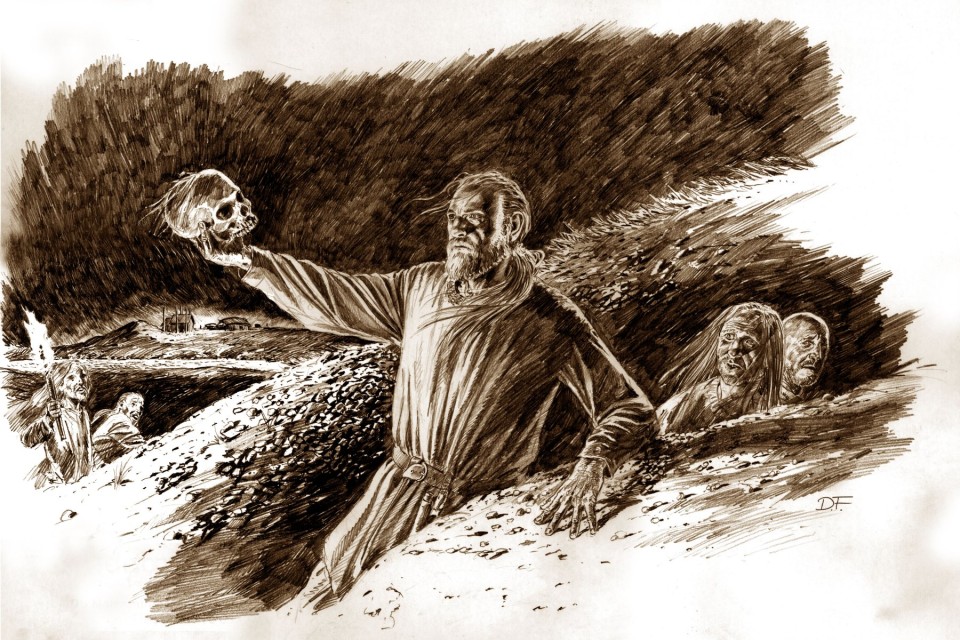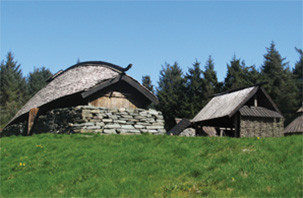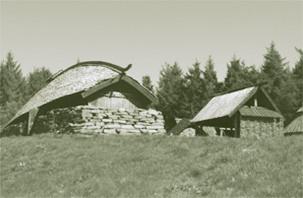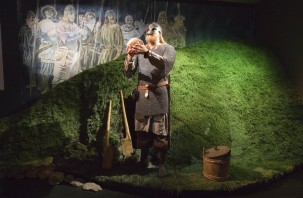Olaf Tryggvason
Text Marit Synnøve Vea
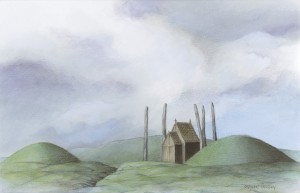
According to tradition it was Olaf Tryggvason who built the first church at Avaldsnes. This church was built on the site of three or five huge sacred stones of the old heathen cult. By doing this Olaf sanctified the old place of sacrifice to Christ. The picture shows how the church and the standing stones may have looked like. (Ill. Steinar Iversen)
(Óláfr Tryggvason) (968 ? – 1000). King of Norway from ca 995 – 1000
Olaf Tryggvason was the grandson of Harald Hairfair. His father was Tryggve Olafsson, a minor king from Viken near the Oslo Fjord, but even in Olaf’s lifetime, people wondered who his father really was. His mother was called Astrid and came from Obrestad in Jæren in Southwestern Norway.
Olaf grew up at the court of the Russian king, went on Viking raids, converted to Christianity and ended his life as the king of Norway. Olaf was revered as a great hero in his own lifetime.
Olaf expert in all exercises
In the Saga Olaf is described like this:
King Olaf was more expert in all exercises than any man in Norway whose memory is preserved to us in sagas; and he was stronger and more agile than most men, and many stories are written down about it. (…)
King Olaf could run across the oars outside of the vessel while his men were rowing the Serpent. He could play with three daggers, so that one was always in the air, and he took the one falling by the handle. He could walk all round upon the ship’s rails, could strike and cut equally well with both hands, and could cast two spears at once.
King Olaf was a very merry frolicsome man; gay and social; was very violent in all respects; was very generous; was very finical in his dress, but in battle he exceeded all in bravery. He was distinguished for cruelty when he was enraged, and tortured many of his enemies.(…)
On this account his friends were attached to him warmly, and his enemies feared him greatly; and thus he made such a fortunate advance in his undertakings, for some obeyed his will out of the friendliest zeal, and others out of dread.
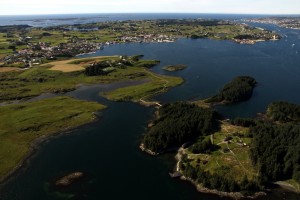
The harbour area of the royal residence. Bottom left; the skerry “Skrattaskjær” where King Olaf Tryggvason let drown a flock of sorcerers. (Ill. KIB Media)
Olaf’s childhood: from slavery to the Russian royal court
The saga tells how Olaf’s early childhood was like a fairytale adventure. Haakon the Good had appointed his father, Tryggve Olavsson, to govern the region of Viken. Tryggve was killed by a relative and his wife Astrid had to flee with Olaf because Gunnhild, the widow of Eric Bloodaxe, wanted to get her hands on the boy, who was then only three years old.
During their escape, Olaf was kidnapped and taken from his mother by Estonian pirates, who sold Olaf to an Estonian farmer. Olaf therefore grew up as a slave until he was 9 years old, when he was found by one of his uncles who bought him back to freedom.
Olaf marries princess Geira from Wendland
After this, Olaf resided at the court of the Russian king until he was 18 years old, when he married Geira, the daughter of King Burizlaf of Wendland in Northern Germany. According to the saga, they loved each other dearly, but after only three years of marriage, Geira died. Olaf mourned her loss deeply and no longer wanted to stay in Wendland.
Olaf sails on Viking raids
Olaf then went on Viking raids and won great acclaim for his exploits. His raids took him to Friesland in the Northwestern Netherlands and Saksland in Northern Germany, to England and the Hebrides and to the Isle of Man and Ireland. He waged many a hard battle and acquired much wealth.
Olaf is probably the “King Anlaf” who appears in anglo-saxon chronicles as the one who attacked London together with the Danish king Svein Forkbeard. The English gave Anlaf/Olaf and Svein 16,000 pounds to keep the peace. Some time later, Olaf changed sides and served the English king instead.
Olaf becomes a Christian and is baptised
In England, Olaf met a Christian monk who could foresee the future and Olaf converted to Christianity. He then sailed to Norway with five longboats, aiming to become king there. In 995, he reached the Norwegian coast. He landed first at Moster in Sunnhordland where he built the first of his churches in Norway.

“Kongshaugen (The King’s Hill). The site for the old thing at Avaldsnes where king Olav Tryggvason is supposed to have christianised the first people of Rogaland county. (Photo Ørjan Iversen)
Olaf toured the country to be hailed as king
Olaf travelled to Trøndelag where he killed Erlend, the son of Earl Haakon. He was then “appointed king” by the Thing (political assembly) in Trondheim, and it was declared, “He shall rule over the same land as Harald Hairfair had under his power.”
In Western Norway Olaf makes an agreement with the farmers. This means among other things that the farmers become Christians. Olaf lets her sister Astrid marry the mighty chieftain Erling Skjalgsson Sola.
Olaf Tryggvason christianise the first people of Rogaland at the King’s Hill/Baptism Hill
It is said that the King’s Hill (Kongshaugen) at Avaldsnes has received its name because King Augvald was buried on this ridge.
According to local traditions and legends, Olaf Tryggvason is purported to have christianised the first people of Rogaland at the King’s Hill (Kongshaugen) at Avaldsnes. It is believed that this was originally the site of the royal court’s assembly, but after Olaf had people baptised there, it was also called the Baptism Height. (See: Konghaugen på Avaldsnes, ”Arkeologi i nord, 2005”,fylkeskonservator Frans-Arne Stylegar)
Olaf Tryggvason, the king who christianised Norway
Olaf is regarded as one of the three kings that christianised Norway. The others were Håkon the Good and Olav Haraldsson (St. Olaf). On several occasions, Olav Tryggvason had to contend with pagan forces at Avaldsnes.

The sorcerers at Skrattaskjær
At Skrattaskjær King Olaf Tryggvason drowned a group of wizards or sorcerers who came to Avaldsnes to kill the King because he brought Christianity to Norway. (Ill: H. Egedius, version with raven)
Skrattaskjær – The Sorcerers Skerry
In the water of the Royal Harbour you can just glimpse “Skrattaskjær” or the “Sorcerers skerry”. The chronicler Snorri Sturlasson tells us that it was here that King Olaf Tryggvason drowned a group of wizards or sorcerers.
On Easter evening in 998 a well-manned long-ship with sorcerers and other dealers with evil spirits came to Avaldsnes. Their leader was Eyvind Kelda, a great grandson of Harald Fairhair. The sorcerers wanted to cast spells over the king because he had brought Christianity to the land. The sorcerers made a thick black mist, but the mist went back on the sorcerers and blinded them.
Olaf’s men captured them, and the king ordered these all to be taken out to a skerry which was under water in flood tide. When the tide came in the sorcerers drowned. Since then the rocks have been called Sorcerers Skerry. (ON Skratte = sorcerer)
This is supposed to have happened in the year 998 AD. At that time the sea level was about 1.5m higher than today.
This story about the sorcerers is told in several old sources. The version in Heimskringla kan be found her: The Sorcerers Skerry
Odin visits Olaf Tryggvason at Avaldsnes
The Saga of Olaf Tryggvason tells that Odin himself visited king Olaf at Avaldsnes at Christmas and told him the story about king Augvald. Odin’s visit to Avaldsnes is first and foremost known through Snorri Sturlassons account in Heimskringla while the older Latin manuscript of Odd munk, Olav’s Saga, provides additional details. Here is the short version told in Heimskringla:
Olaf and Odin’s Apparition.
It is related that once on a time King Olaf was at a feast at this Ogvaldsnes, and one eventide there came to him an old man very gifted in words, and with a broad-brimmed hat upon his head. He was one-eyed, and had something to tell of every land. He entered into conversation with the king; and as the king found much pleasure in the guest’s speech, he asked him concerning many things, to which the guest gave good answers: and the king sat up late in the evening. Among other things, the king asked him if he knew who the Ogvald had been who had given his name both to the ness and to the house.
The guest replied, that this Ogvald was a king, and a very valiant man, and that he made great sacrifices to a cow which he had with him wherever he went, and considered it good for his health to drink her milk. This same King Ogvald had a battle with a king called Varin, in which battle Ogvald fell. He was buried under a mound close to the house; “and there stands his stone over him, and close to it his cow also is laid.” Such and many other things, and ancient events, the king inquired after.
Now, when the king had sat late into the night, the bishop reminded him that it was time to go to bed, and the king did so. But after the king was undressed, and had laid himself in bed, the guest sat upon the foot-stool before the bed, and still spoke long with the king; for after one tale was ended, he still wanted a new one. Then the bishop observed to the king, it was time to go to sleep, and the king did so; and the guest went out.
Soon after the king awoke, asked for the guest, and ordered him to be called, but the guest was not to be found. The morning after, the king ordered his cook and cellar-master to be called, and asked if any strange person had been with them. They said, that as they were making ready the meat a man came to them, and observed that they were cooking very poor meat for the king’s table; whereupon he gave them two thick and fat pieces of beef, which they boiled with the rest of the meat.
Then the king ordered that all the meat should be thrown away, and said this man can be no other than the Odin whom the heathens have so long worshipped; and added, “but Odin shall not deceive us.”
Olaf Tryggvason opens several burial mounds at Avaldsnes.
The manuscripts after Odd munk have more complete details about these events, and goes on to tell that Olaf the next morning digs in the burial mounds of which Odin had spoken. In one of the mounds he found human remains and in the other he found the remains of a cow.

Location of Green Mound (Gønhaug) in relation to the Royal Manor at Avaldsnes. Green Mound marked with red.
Ritual Grave Robbing by Olaf Tryggvason?
Only a few very wealthy ships graves from the early Iron and Viking Age have been found in Northwest Europe. Two of these graves, known as Green Mound (Grønhaug) and Great Mound (Storhaug), can be found close to the ancient royal residence, Avaldsnes.
The excavation of Green Mound in 1902 revealed a ship that was 15 m long and 3m wide. The dead person had been placed upon eiderdowns in the middle of the ship during the burial which took place in 795. He was wearing red clothing and was surrounded by tapestries depicting a variety of figures. The presence of English glass bowls was also a sign of great luxury.
The grave had been desecrated a long time ago. Someone had removed traditional symbols of power, such as swords, daggers and gold rings and had even taken large parts of the skeleton. However, it was easy to determine, from what remained of both the ship and the treasure that the person buried here had been very wealthy indeed.
It would have been impossible for this grave robbing to take place in secrecy as the mound was situated such that it was clearly visible from the royal estate at Avaldsnes. It is therefore believed that this was a ritual grave robbing organised by the royal estate. But what was the motive for this break-in?
Was it an attempt by a new dynasty to show their power over the former rulers? Or was the robbing intended to Christianise a deceased ancestor, in line with the events at Jellinge, where the Danish Christian king, Harald Bluetooth removed the buried remains of his ancestors Gorm and Tyra from the burial mound and laid them to rest inside the church?
Before the grave was reclosed after the robbery, a burning candle, a traditional Christian symbol, had been placed inside the mound. This may indicate that the latter interpretation is the correct one
The saga tells of how the Christian king Olaf Tryggvason excavated the burial mounds at Avaldsnes. Could he have been responsible for the opening of Green Mound?
When Olaf Tryggvason became king, many people doubted that he was a descendant of Harald Fairhair. Could it be that Olaf opened Green Mound to prove his kinship with the dynasty founder Harald Fairhair?
The Long Serpent – Ormen Lange
The Norse sagas prize many of the Viking warships. Olaf Tryggvason built the most legendary of them all; the Long Serpent. King Olav got the idea to build this ship in Northern Norway, when he stole a sturdy dragonship from Raud den Ramme in Hålogaland, after having killed the ship owner. It may seem like it was in Northern Norway these solid and strong ships were first developed:
The Saga of Olaf Tryggvason describes the Long Serpent like this:
“The winter after that King Olaf was come from Halogaland, caused he to be built under the cliffs at Ladir a great ship: a ship far mightier than any other ship of that land (…). All the material was of the choicest, and the ship was both long and broad, built with great beams, and the bulwarks thereof were high.(…)
The ship was both long and broad and high-sided, and strongly timbered. (..) The ship was a dragon, built after the one the king had captured in Halogaland; but this ship was far larger, and more carefully put together in all her parts. The king called this ship the long Serpent, and the other the Short Serpent. The Long Serpent had thirty-four benches for rowers. The head and the arched tail were both gilt, and the bulwarks were as high as in sea-going ships. This ship was the best and most costly ship ever made in Norway. “ (The saga of Olav Tryggvasons).
The sagas describe the Long Serpent as a dragon ship, where the qualities of the sea-going sailing ships are combined with the warships need for oars and rowers…“the bulwarks were as high as in sea-going ships”.
The large solid ship long Serpent was neither the fastest sailor nor the best rowing ship in the King’s fleet. Still, the saga says that: “This ship was the best and most costly ship ever made in Norway”. From the descriptions in the sagas, it seems that the Long Serpent was a “busse”, but in one skaldic poem it is called a skeid.
The size of the Long Serpent
The Long Serpent had 34 benches for rowers, ie 34 sections, 68 half-sections and 68 oars. The chronicler Snorri Sturlason tells that: In every half-section were eight men, and each and all chosen men; and in the fore-hold were thirty men. According to Snorri, the Long Serpent had a crew of 574 men.
It is estimated that the Long Serpent was between 47 – 48m long. Some even say that the ship was up to 57m long, depending on the alen (cubit) measurement that was used.

Erik’s men board the Long Serpent. Saga of Olaf Tryggvason. Ill. Halfdan Egedius
The battle at Svolder (year 1000)
Tyra, the sister of the Danish king, fled from her marriage with the king of Wendland, Burizlaf, and came to Olaf, who married her. In the year 1000 Olaf set off to fetch her property in Wendland. He managed this successfully, and he sails home with a fleet of 11 ships. At Svolder (in the Baltic Sea?)he was attacted by the Danish king Sweyn Forkbeard, the Swedish king Olof Skötkonung and the Norwegian earl Erik of Lade. This alliance had a fleet of 70 ships.
In the Saga of Olaf Tryggvason we can read:
King Olaf stood on the Serpent’s quarterdeck, high over the others. He had a gilt shield, and a helmet inlaid with gold; over his armour he had a short red coat, and was easy to be distinguished from other men. When King Olaf saw that the scattered forces of the enemy gathered themselves together under the banners of their ships, he asked, ” Who is the chief of the force right opposite to us?”
He was answered, that it was King Svein with the Danish army.
The king replies, ” We are not afraid of these soft Danes, for there is no bravery in them; but who are the troops on the right of the Danes?”
He was answered, that it was King Olaf with the Swedish forces.
“Better it were, ” says King Olaf, ” for these Swedes to be sitting at home killing their sacrifices, than to be venturing under our weapons from the Long Serpent. But who owns the large ships on the larboard side of the Danes?”
“That is Earl Eirik Hakonson, ” say they.
The king replies, ” He, methinks, has good reason for meeting us; and we may expect the sharpest conflict with these men, for they are Norsemen like ourselves.” See: THE BATTLE OF SVOLDER IN OLAF TRYGGVASONS SAGA
Did Olaf Tryggvason survive the Battle of Svolder?
Olaf had to admit defeat against the forces at Svolder. He was wounded and jumped overboard with his armour on. It was a foregone conclusion that the armour would weigh him down and drag him to the bottom of the sea. Nevertheless, rumours began to circulate that Olaf had managed to cast off his armour and swim underwater to a waiting ship. These rumours also appear in Snorre’s saga.
Tormod Torfæus relates that Olaf journeyed to Rome and Jerusalem
In his work Historia Rerum Norvegicarum, the historian Tormod Torfæus writes about the rumours that Olaf had survived the Battle of Svolder and that he ended his days as a holy man in Jerusalem.
Back

